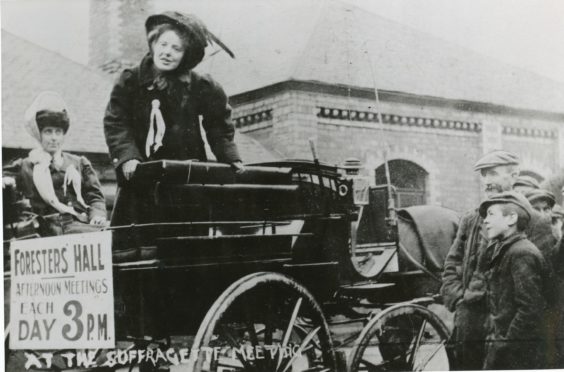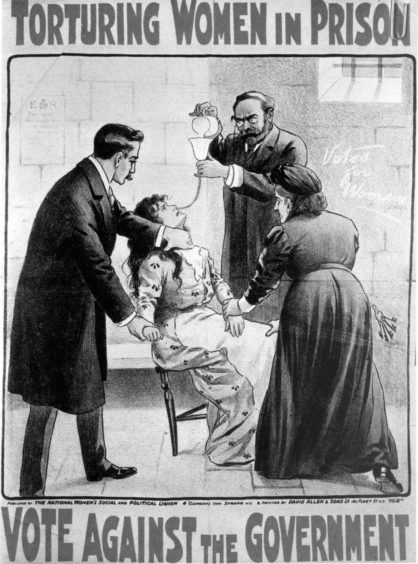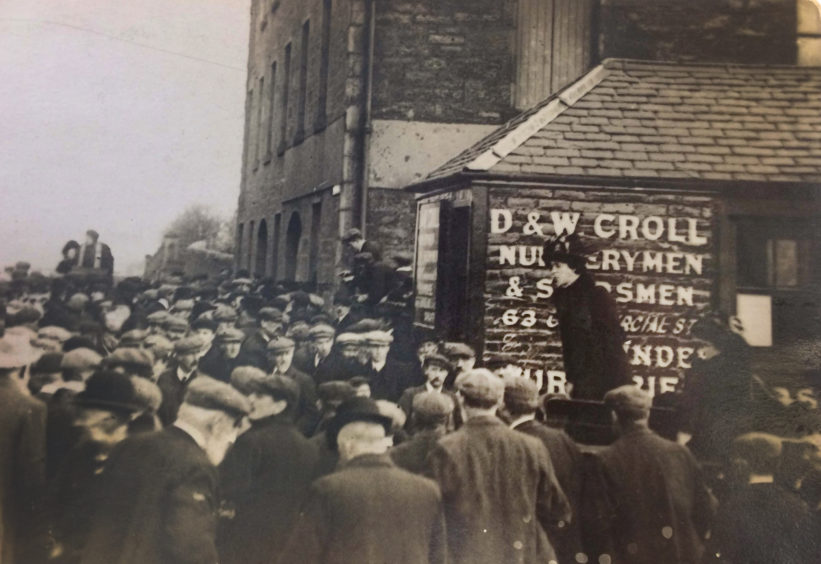Today marks exactly 100 years since some women first won the vote, with 8.5 million women eligible. Caroline Lindsay finds out more about the Suffragettes’ epic struggle for equality.
Women had more than proved themselves during the First World War, as Dr Derek Patrick of the University of St Andrews points out: “Dundee’s women made a tremendous contribution to the war effort. They had always been predominant in the textile industry but during the war worked in munitions, the Caledon shipyards, and occupied a range of jobs usually reserved for men.
“Many women served as nurses on the Home Front and in various theatres of war, tending the wounded in several locations in and around Dundee including the Eastern Hospital, Royal Infirmary, the Caird Rest, the lodge, Broughty ferry and Messrs Cox’s Schools, Lochee. Away from the workplace woman had a key role in fundraising which helped support soldiers at the front and fund other initiatives,” he continues.
But once peaceful methods had failed to win them the vote, they stood by their motto “deeds not words”, and chained themselves to railings, disrupted meetings and damaged public property – including setting a fire at Leuchars station – in their fight for equality.
>>24 Days of Christmas – Click here for special festive deals from some of our favourite local businesses
Their action provoked a great deal of anger and lost them support, yet their passion, courage and conviction are widely admired today. Author and historian Dr Norman Watson has been researching the suffragette movement in Courier Country for 30 years and believes Perth and Dundee played a pivotal role in promoting the votes for women campaign.
“Scotland’s first act of militancy, the first disruption of a public meeting, the first arrests and the first hunger strikes all took place in Dundee,” he said. “Moreover, some of Britain’s most militant acts, many of its largest demonstrations and most violent confrontations all took place in the city. “Although there was no leader of the suffragette movement in Scotland, its recognised figurehead was Dundee’s Ethel Moorhead, who became the first woman to be forcibly fed in Scotland, while Perth was the scene of the forcible feeding of four suffrage prisoners in 1914.”
In 1905, Emmeline Pankhurst decided on militant methods to generate the publicity they thought would be needed in order to obtain the vote. Her daughter Christabel, then a 23-year-old law graduate, and a mill girl recruit called Annie Kenney were arrested in London in 1905 for allegedly attacking a policeman. They refused to pay the fine and were sent to prison. This shocked the nation as women had never been jailed before for political action.
Norman continued: “The publicity attracted hundreds of women to the cause.
It quickly moved out of London and into the provinces and by 1906, Dundee had its own branch of the WSPU, led by Annette Wilkie, who, in 1908, became the city’s first campaigner to be jailed. “What really focused attention on Tayside was not only the fact that Liberal Prime Minister Herbert Asquith had his seat in North Fife,” Norman continued.
“The real catalyst was the arrival of Winston Churchill in Dundee in 1908 to stand for election as a Liberal MP.”
Churchill was by then a powerful political figure and was greeted at the city’s railway station by thousands of Liberal supporters. However, his appearance was also awaited eagerly by growing ranks of women protesters. Emmeline Pankhurst herself promised him a warm welcome and such was the women’s determination to upset Churchill’s campaign, that 27 of the movement’s big guns – including Mrs Pankhurst and her daughters Christabel, Adela and Sylvia, Millicent Fawcett, the leader of the National Union of Women’s Suffrage Societies, and Charlotte Despard, leader of the Women’s Freedom League – converged on the city.
Norman went on: “Hundreds were turned away from Mrs Pankhurst’s meetings. Mary Gawthorpe was cheered again and again at Dundee Stock Exchange. Mary Leigh invaded The Courier office but left with three cheers from the staff. Helen Fraser spoke to 10,000 people at Dundee High School Gates. And up at Dens Park, the entire Rangers team was persuaded to wear Votes for Women badges before a cup-tie with Dundee.”
Above all, however, the Dundee by-election of 1908 is remembered for Mary Maloney’s bell. “Mary was a London member of the Women’s Freedom League, a talented speaker who had taken part in various major demonstrations,” said Norman. “Mary vowed to pursue Churchill to exact a public apology – which brought her to Dundee. Whenever Churchill spoke, she produced a large hand bell, which drowned out what he was saying, or, at least, caused a noisy diversion. Her actions were taken in fun initially but some meetings had to be cancelled because of the uproar she caused.
In July of that year, the jailed Scottish suffragette Marion Wallace Dunlop refused prison food and undertook the first hunger strike. “By the summer of 1914, four women were being forcibly fed in Perth Prison, causing outrage through Scotland – 3,000 women kept a silent vigil outside the prison,” said Norman.
“It took great courage to finally achieve a partial victory in 1918.
“They had to defy their upbringing and be visible at demonstrations, give speeches to a mob, interrupt political meetings, sell suffrage literature in the street, collect money and occasionally commit acts of civil disobedience.
“They often risked their reputations and career success – and sometimes their chance of marriage. They were even certified as insane.”
Dr Kenneth Baxter of Dundee University reflected: ”
“In Dundee the suffrage movement had been strong, partly due to Churchill representing the city from 1908, but also due to its proximity to Asquith’s Fife consistency. Indeed, Christabel Pankhurst indicated that when she came to Dundee in September 1906 that she wanted a strong branch of the WSPU in the city so as it could operate against Asquith in Fife.
“The suffragettes must be said to be part of the reason the parliamentary vote was granted to some women in 1918, but we also need to remember other factors were involved,” he continued.
“The non-militant campaigns of suffragists were important, as was the work women did during the War, which made the anti-suffrage case much more difficult. Equally what happened in 1918 can be seen as part of natural evolution of the democratic process. Women had increasingly gained right to vote and participate in local elections in the late 19th and early 20th Century and other countries were moving to enfranchise women at the same time.
“In the long term a female electorate changed party politics in Scotland and Dundee. Political parties could no longer afford to have male only organisations and campaigns and electioneering aimed at winning female voters very quickly became a key feature of national and local elections.
“While the bravery of these women ensured the vote for some women at least – those aged 30 and over who resided in the constituency or occupied land or premises with a rateable value above £5, or whose husbands did – it wasn’t to be until 1928 that the Equal Franchise Act was passed, ensuring that all women aged 21 and over finally had equal voting rights with men.













